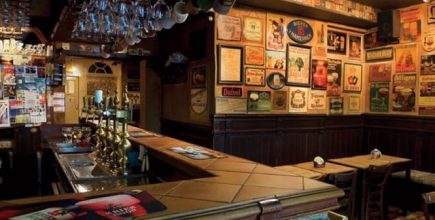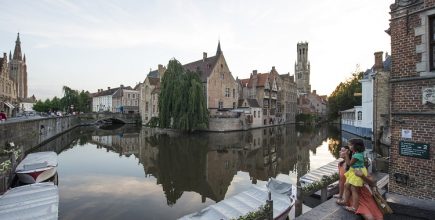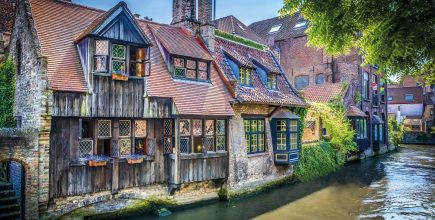01 Setting the scene
Bruges (Brugge)
Bruges, gleaming out of the flat lands of Belgium like a gold nugget in the pebbles, is a medieval masterpiece, one of the wonders of Europe, and just over the Channel.
This tight-packed city, popular though it is to tourists, is scarcely touched by the tide of history.
Among the nearest historic cities on the continent, it’s one of the few daytrip cities, at least from London and the South East.
02 What to see and do
Close call
Just 80 minutes from the Eurotunnel at Calais (74 miles), Bruges is close enough for an impulse visit any time of year.
Park at the main railway station and take the bus, or a short walk, into the centre. I prefer the train to Brussels, then a quick, direct connection (rail connections within Belgium are free for Eurostar passengers).
It was British tourists, en route to the Waterloo battlefield in the early 1800s, who rediscovered a city in slumber, unchanged since its glory days in the 14th and 15th centuries. The enduring feature over the centuries, summoning in traders and visitors from all across flat Flanders, is the Belfry (272 feet) on Markt (Market Square). It’s worth climbing the 366 steps for the stupendous views.
High tech history
“Venice of the north” is meant as a compliment, but it doesn’t do Bruges justice. Until its sudden decline in the 1400s, this was the beating heart of Northern Europe. It was the headquarters of the Hanseatic League, which controlled Baltic trade. Florence’s Medici family ran a bank for Italian traders from Hof Bladelin mansion, still there on Naaldenstraat.
Now we can reimagine that history. Bruges is one of the first cities to offer visitors the new virtual reality (VR) technology, which surely will play a big part in city tourism. The Historium Museum issues people who take its city centre tour with Google Cardboard VR headsets. On the projection before your eyes, you get to “see” buildings, some of them long gone, in their original mediaeval setting.
Art with soul
Frank Brangwyn was an artist of two nations, honoured in his native Bruges, but let down by the British establishment. The Arentshuis Gallery holds 400 works he donated to the city. Dark, sinewy paintings, such as shipyard workers dwarfed by the monster vessels they built, and drawings extol honest toil. Brangwyn’s father was from Buckinghamshire; his mother was Welsh. They moved to Bruges, where Frank was born. He received two commissions from the House of Lords, but the peers rejected both. His WW1 battle scenes were “too grim”; his British Empire Panels “too colourful”. Today they hang, respectively, in Cardiff’s National Museum of Wales and Swansea’s Brangwyn Hall.
Film set
“In Bruges” stars Colin Farrell and Brendan Gleeson as hit men exiled to the city by their mobster boss (Ralph Fiennes), who later joins them for a final reckoning. The film crew gained unprecedented access to the city’s locations. Fiennes said Bruges was an additional character in the story. Director Martin McDonagh said: “They let us film in just about every stunning location I wanted.” His favourite locations include Market Square, dominated by the mighty 270 feet Belfry, where he filmed a chase involving the gun toting gangsters. Another important location was the nearby Burg Square. And although the scene shifts to other well-known places such as Minnewater, the actors also visit less frequented spots such as Astridpark and Jan van Eycklplein Square, under the statue of the famous Flemish painter van Eyck. Indoor scenes were shot in the city too –not in the studio — in such locations as Cafedraal Restaurant, Diligente Bar, and the terrace of Restaurant de Beurze.
Groeninge Museum
The Groeningemuseum, Bruges’ most celebrated art gallery, holds a fine collection focussing on the classical painters: Flemish Primitives and Renaissance artists. ‘Madonna with Canon George Van der Paele’ by Jan Van Eyck is one of the collection’s masterpieces.
There are works of surrealist pioneers such as Paul Delvaux and René Magritte. Actors Colin Farrell and Brendan Gleeson, in the movie In Bruges, managed to get close up and philosophical with Hieronymus Bosch’s Last Judgment, one of the most remarkable masterpieces in the museum. It’s rare for film crews to be allowed so close to such valuable paintings. Next door is the Memling Museum, with works by the Flemish master Hans Memling,
A passion for chocolate
Two of Belgium’s national passions, beer and chocolate, are showcased in Bruges. Sukerbuyc in Katelijnestraat (www.sukerbuyc.be) is a small family business producing hand-made chocolate. Their cafe has an endearing tradition: even when you opt for a cup of tea, they serve on a side dish the cream you would[italics] have had if you had ordered coffee. And you get chocolate with every hot drink. Close by is chocolate museum Choco-Story, telling how the cocoa bean seduced us from the Mayas and the Aztecs through to today’s global addiction. www.choco-story.be
(There’s a museum of lamps in the same building, with a museum of that other Belgian obsession, chips, to follow him I believe this is the sometime this year). De Halve Maan, the only brewery left in the city is open for daily visits. www.halvemaan.be The latest brew, Brugse Zot (Bruges Lunatic),is everywhere. You’d be mad not to try it. Or maybe not.
Drink Up
The De Halve Maan brewery in the centre of Bruges devised a radical plan to combat the congestion slowing its deliveries. It sank a two mile polyethylene pipe under the streets and now sends its beer to a bottling plant. The brewery offers daily tours, and has a restaurant overlooking the canal. One of the cosiest havens in this city of many pubs and beers is De Garre, down a small alley near the Belfry. It serves De Garre triple, so strong (11% ABV) customers are limited to three glasses. Bruges’s other speciality is chocolate, with plenty to tempt you in the windows of independent shops. For waffles, try Tearoom Carpe Diem. Chips are celebrated in Frietmuseum.
03 Places to stay
Smart canalside hotels in central Bruges
There are some smart canalside hotels in central Bruges. It was in the De Tuilerieen where the stars of the movie “In Bruges” stayed, and they have the signed photographs up to prove it. They put me into Ralph Fiennes’ rooftop room. I can confirm that the actor had an inspirational view of the city skyline. (www.hoteltuilerieen.com) If you can’t get in, the nearby hotel Relais Bourgondisch Cruyce (it’s in the film) is just as splendid. Staying in any of these city centre hotels, you only have to step across the road before breakfast for the very best views of Rozenhoedkaai. (Or the last glimpse at night, when swans cruise on still, floodlit waters). This is a glorious, if busy. viewpoint. The canal view from the Molenbrug, the bridge on Hoogstraat is quieter.
04 places to visit nearby
Brussels
If you arrived by train, there’s a good chance you travelled via Brussels on the Eurostar. If you have time before your train home, take a walk around the city centre.
Mechelen (Malines) is the smallest of the Flemish art cities. It is halfway between Antwerp and Brussels, and more compact, but still has a good selection of impressive historic buildings and heritage sites. The River Dijle meanders through the city. It is enclosed by the Zoutwerf (Salt Quay) with its 16th century wooden frontages and the Haverwerf (Oat Quay) with its pastel-coloured decorative facades. The Lamot brewery complex serves as a congress and heritage centre. Well renovated in a contemporary architectural style, it is a good example of how upgrading industrial archaeology can revitalise a city. Saint Rombouts Cathedral is he centre point; two carillons of bells hang in its 97metre-high tower. The former palace of Margaret of Austria was once the seat of government for the Netherlands.
www.visitmechelen.be
There is a train connection between Bruges and Mechelen, with a single change in Ghent (Sint-Pieters), Bruxelles-Midi
(Brussels-South) or Bruxelles-Nord (Brussels-North), depending on your day of travel (around hour and 20 minutes.



